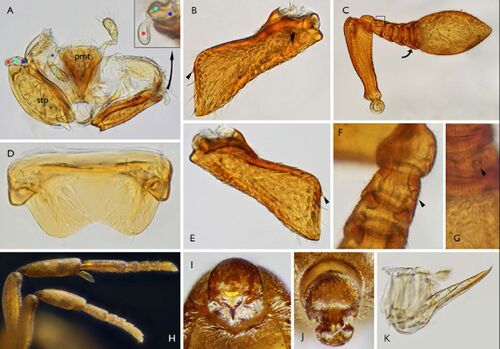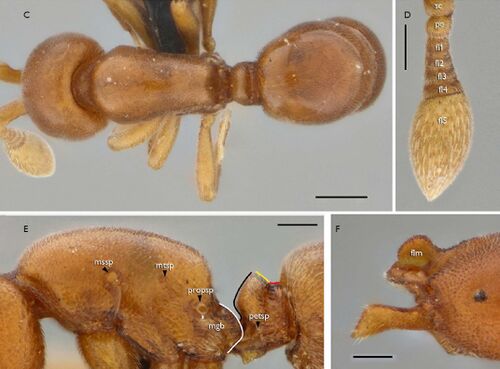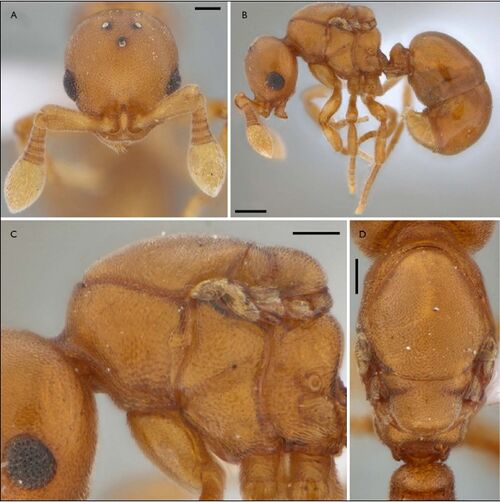Discothyrea bobi
| Discothyrea bobi | |
|---|---|

| |
| Scientific classification | |
| Kingdom: | Animalia |
| Phylum: | Arthropoda |
| Class: | Insecta |
| Order: | Hymenoptera |
| Family: | Formicidae |
| Subfamily: | Proceratiinae |
| Tribe: | Proceratiini |
| Genus: | Discothyrea |
| Species: | D. bobi |
| Binomial name | |
| Discothyrea bobi Chaul, 2020 | |
The type locality is a mountain range in southeastern Brazil, the Serra do Brigadeiro, located 40 km from the Viçosa municipality. The D. bobi type series was sampled between 1300 and 1800 meters. It has never been sampled in Viçosa (average height 700 m), despite it having a well-sampled, and well-known, ant fauna. The area around the type location has been only occasionally explored.
Identification
Antenna with seven antennomeres. Head widest point posterior to its midlength. Frontal lamella in full-face view thickened. Poorly formed corners between lateral and vertexal margins of the head in full-face view. Integument only mildly sculptured, moderately shiny in some parts. Propodeal spiracle very close to metapleural gland bulla, not protruded in dorsal view. Angle of lateral to declivous propodeal faces round. Subpetiolar process low, triangular, with a sharp anterior angle. Relatively large species.
Discothyrea bobi is most similar to Discothyrea neotropica, a species described based on a dealate queen from Argentina. Important traits they share are: a 3, 2 palpal formula; the subrectangular frontoclypeal structure (as opposed to semicircular); a thickened frontal lamella in full-face view; the propodeal spiracle very close to the metapleural gland bulla; the overall shape of the petiole, without a long subpetiolar process.
The queen caste of D. neotropica appears to be larger than D. bobi and has an opaque integument, as opposed to weakly sculptured and partially polished, as seen in D. bobi.
D. neotropica differs from D. bobi by having the integument entirely opaque; the lateral and vertexal margins of the head in full-face view being relatively well-defined (head appearing less round than in D. bobi); angle between propodeal dorsal and declivous margins in profile more defined; denser pubescence on body.
Keys including this Species
Distribution
Minas Gerais, Brazil.
Distribution based on Regional Taxon Lists
Neotropical Region: Brazil (type locality).
Distribution based on AntMaps
Distribution based on AntWeb specimens
Check data from AntWeb
Countries Occupied
| Number of countries occupied by this species based on AntWiki Regional Taxon Lists. In general, fewer countries occupied indicates a narrower range, while more countries indicates a more widespread species. |

|
Biology
Castes
Morphology
Worker
Queen
Nomenclature
The following information is derived from Barry Bolton's Online Catalogue of the Ants of the World.
- bobi. Discothyrea bobi Chaul, 2020: 202, figs. 1-3, 5 (w.q.) BRAZIL.
- Type-material: holotype worker, 5 paratype workers, 1 paratype queen.
- Type-locality: holotype Brazil: Minas Gerais, P.E. Serra do Brigadeiro, 1600 m., i.2007, Winkler (R. Solar); paratypes with same data except for varying altitudes.
- Type-depositories: UFVB (holotype); DZUP, INPA, MPEG, MZSP, UFVB (paratypes).
- Distribution: Brazil.
Type Material
- Holotype, worker, P. E. Serra do Brigadeiro, Minas Gerais, 1,600m, Brazil, 20°39′S 42°24′W / 20.65°S 42.40°W, January, 2007, R. Solar, UFV-LABECOL-000035, Entomological Collection of the Laboratory of Systematics and Biology of Coleoptera at the Universidade Federal de Viçosa, Viçosa, Minas Gerais, Brazil; winkler.
- Paratypes: Five pinned workers and one pinned dealate queen with same data as holotype, except for altitude of sampling point:
- CELC: UFV-LABECOL-000036, queen, altitude 1,800 m
- MZSP: UFV-LABECOL-000033, worker, altitude “1300-1800 m”
- DZUP: UFVLABECOL-000050, worker, altitude “1,300-1,800 m”
- MPEG: UFV-LABECOL-010838, worker, altitude 1,600 m
- INPA: UFV-LABECOL-000034, worker, altitude 1,500 m
- JTLC: UFV-LABECOL-000114, worker
Description
Worker
Holotype (UFV-LABECOL-000035): HL 0.525, HW 0.43, SL 0.27, AantL 0.23, AantW 0.145, PW 0.31, WL 0.55, HFL 0.32, PeW 0.17, PeL 0.12, LT3 0.4, LT4 0.29, TL 1.885. Paratypes UFV-LABECOL-000050: HL 0.54, HW 0.54, SL 0.3, AantL 0.24, AantW 0.16 PW 0.31, WL 0.585, HFL 0.35, PeW 0.17, PeL 0.12, LT3 0.4, LT4 0.32, TL 1.965. UFV-LABECOL-000034: HL 0.53, HW 0.44, SL 0.29, AantL 0.23, AantW 0.15, PW 0.32, WL 0.57, HFL 0.33, PeW 0.17, PeL 0.12, LT3 0.42, LT4 0.31, TL 1.95. UFV-LABECOL-000033: HL 0.54, HW 0.44, SL 0.3, AantL 0.24, AantW 0.155, PW 0.32, WL 0.58, HFL 0.35, PeW 0.175, PeL 0.12, LT3 0.4, LT4 0.33, TL 1.97. UFV-LABECOL-010838: HL 0.54, HW 0.44, SL 0.3, AantL 0.24, AantW 0.155, PW 0.32, WL 0.58, HFL 0.35, PeW 0.17, PeL 0.12, LT3 0.42, LT4 0.31, TL 1.97.
Matching the diagnosis of the genus given in Hita-Garcia et al. (2019a).
Head. In full-face view, head posterior margin without clear distinction of the lateral and vertexal margins, widest at two thirds of its length. Mandible masticatory margin edentate, except for the apical tooth and a subbasal denticle. Inner surface of mandible, close to the masticatory edge, with a row of thick specialized setae. Palpal formula 3,2. Basal maxillary palpomeres 1 and 2 fused, appearing as one, encrusted on apicomedial margin of stipe. Apical maxillary palpomere clavate and small. Labial basal palpomere tube-like, bent at base; labial apical palpomere inflated and covered on various fine setae (while other palpomeres are entirely or mostly glabrous). Labrum roughly rectangular, with a concave middle section of its distal margin, covered with small setae. In profile view of the head, frontal lamella a large and blunt lobe with a translucent anterior patch; in full-face view, the lamella is thickened, roughly oval. Eye small but distinct; in full face view situated anterior to midlength of head. Ommatidia difficult to count, appearing as partially fused to each other. Frontoclypeal structure strongly projected, having somewhat distinct lateral and anterior margins in full-face view; the lateral margin being oblique, and the anterior margin slightly convex. Antenna heptamerous, antennomeres 3 and 6 (flagellomere 1 and 4, respectively) having one tiny pit each, the former dorsolaterally on flagellomere and the latter ventromedially. Apical antennomere 1.3x longer than other flagellomeres and the pedicel combined. Cephalic capsule with weak sculpturing all through, except for hypostomal bridge, which is smooth. Mesosoma. In profile view, dorsum of mesosoma evenly arched, meeting the declivous margin in a round angle. In profile, declivous margin apical half flat, its basal half, the propodeal lobe, protruded, convex.
Declivous propodeal surface flat, with poorly defined corners in relation to lateral and dorsal propodeal faces. Katepisternum delimited, somewhat raised from the level of other pleural sclerites around it. Mesosoma lateral margins in dorsal view gradually tapering posteriorly. Propodeal spiracle not protruding in dorsal view; in profile view considerably large and lowered, almost touching the metapleural gland bulla. Mesonotal spiracle about as large as propodeal, entirely covered by the pronotum but clearly distinguishable for being a raised area; metanotal spiracle a minute spot on lateral mesosoma surface, closer to propodeal spiracle than to mesonotal. Anterior tibia having the calcar, mesotibia without spur, and metatibia having a single, large pectinate spur. Mesosomal sculpturing poorly developed, with dorsum of mesosoma being less sculptured than the lateral surfaces; metapleuron and particularly the katepisternum having stronger sculpturing than surrounding sclerites. Metasoma. Subpetiolar process low, developed as a translucent carina which gradually widens anteriorly where it forms well-defined angle. In profile, anterior margin of petiole sinuous, and posterior margin oblique, both meeting to form a peak which is posteriorly displaced along the length of the petiole. The posterior margin ends in a short, flat portion which is the apex of a posterior petiole ring. Petiole spiracle facing ventrally and much smaller than propodeal spiracle. Posterior petiole tube or collar very wide, having about three quarters of petiole height, discounting subpetiolar process. Anterior portion of abdominal segment III forming a concave area where presclerites sit in the middle, the area is well-delimited ventrally by a V-shaped carina (the prora) and dorsally by a non-carinated folding of the tergite. In profile view, length of poststernite III slightly greater than a third of length of posttergite III; length of poststernite IV less than a tenth of length of posttergite IV. Area of abdominal segment III (A3) in profile appearing slightly greater than that of abdominal segment IV (A4). In dorsal view, A3 width approximately 2.4x greater than petiole width. Posttergite III posteromedially having a low tumulus. In the dorsal view of A3 and A4, A3 only slightly wider than A4 and with a mild constriction between them. Sting small, thick at base and sharp apically. Petiole more sculptured than other parts of the body. A3 smooth laterally, punctate posteromedially. A4 the shiniest sclerite on body, smooth all through. Pilosity and coloration. Body covered with small, filiform, whitish pubescence, only last abdominal segments having suberect small setae, starting on the edge of A4 but denser only on A7, especially on sternite (hypopygium). Body having light brown, ferruginous coloration, with antennae and legs being slightly lighter.
Queen
Paratype (UFV-LABECOL-000036): HL 0.52, HW 0.46, SL 0.3, EL, 0.125, AantL 0.24, AantW 0.15, WL 0.66, PW 0.35, MssctmW 0.38, MssctmL 0.39, MstxL 0.54, HFL 0.36, PeW 0.19, PeL 0.13, LT3 0.48, LT4 0.33, TL 2.12.
Dealate: Agreeing with the description of the worker except in the following. Head with three small ocelli and large compound eyes. Minute setae in between ommatidia of compound eye. Mesosoma drastically different from workers, much larger and typical of winged queens. Dorsally, mesoscutum very large; scutoscutellar suture poorly marked, therefore weak delimitation of mesoscutellum anteriorly and of axillae posteriorly. Propodeum in dorsal view forming two round projections posterad. In profile view, propodeum dorsal margin short and meeting the declivous margin in a round angle. Propodeum posterior surface concave in dorsal view. Oblique mesopleural suture and mesometapleural suture well-marked. Metapleuropropodeal suture absent. Metasoma larger than in workers. Subpetiolar process having a denticle anteriorly rather than merely an angle as in workers.
Etymology
The species is named after ecologist, myrmecologist, and friend Ricardo Solar, also known as Bob, who has sampled the entire type series.
References
- Boudinot, B.E., Richter, A., Katzke, J., Chaul, J.C.M., Keller, R.A., Economo, E.P., Beutel, R.G., Yamamoto, S. 2022. Evidence for the evolution of eusociality in stem ants and a systematic revision of †Gerontoformica (Hymenoptera: Formicidae). Zoological Journal of the Linnean Society XX:1-35 (doi:10.1093/zoolinnean/zlab097/6523228).
- Chaul, J.C.M. 2020. A new species of Discothyrea Roger (Hymenoptera: Formicidae) from the Brazilian Atlantic Rainforest. Boletim do Museu Paraense Emílio Goeldi. Ciências Naturais 15(1): 199-217 (doi:10.46357/bcnaturais.v15i1.266).
- Richter, A., Boudinot, B.E., Hita Garcia, F., Billen, J., Economo, E.P., Beutel, R.G. 2023. Wonderfully weird: the head anatomy of the armadillo ant, Tatuidris tatusia (Hymenoptera: Formicidae: Agroecomyrmecinae), with evolutionary implications. Myrmecological News 33: 35-75 (doi:10.25849/MYRMECOL.NEWS_033:035).




